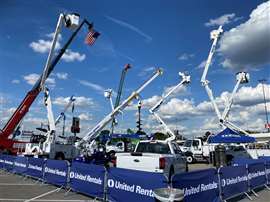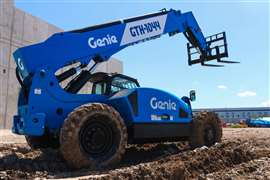Read this article in Français Deutsch Italiano Português Español
5 simple tips to help contractors keep rental costs down
19 March 2024
The US construction rental market is busy, according to data from the US American Rental Association (ARA), with year-over-year growth shattering expectations. But, how can contractors manage rising costs in the US$71.5 billion rental industry?
 United Rentals at the 2023 Utility Expo in Louisville, US. (Photo: IRN)
United Rentals at the 2023 Utility Expo in Louisville, US. (Photo: IRN)
The rental segment was poised to advance – original expectations from ARA saw 7.6% growth for 2023 and 3.1% for 2024 – but perhaps not this quickly. Adjusted numbers, forecasted last November, showed significant increases: 2023 is expected to see an 11.8% increase for the year and 2024 upgraded to 7.1% growth.
For Josh Nickell, VP of the equipment segment for the ARA, it’s a sign that the industry is moving away from an ownership economy.
“I think a lot of contractors are realising you don’t have to own everything, and America’s always been an ownership economy,” said Nickell, noting that younger generations entering the workplace are more familiar and comfortable with sharing responsibilities. The popularity of ridesharing or home rental apps are a sign that “more contractors are more comfortable with renting. They grew up with this idea.”
Jason Perez, CEO of Yardz – a construction rental technology company – noted, however, that with sector growth can come increased costs for contractors.
“The first step in addressing this issue is understanding the factors that are contributing to the rise in rental costs,” he said, noting that “economic fluctuations, increased demand for construction services, a shortage in equipment supply, and higher maintenance costs for equipment are among the key drivers.
“These factors combine to create a market in which rental prices are consistently escalating, placing additional financial burdens on contractors,” he added.
With the ratio of rented-to-owned on the rise domestically, Perez suggested rental costs won’t be diminishing anytime soon.
He said US contractors follow these five tips to stay ahead of the mounting costs:
1) Negotiate initial rates
Perez said the first step contractors can take to manage rental costs is negotiating rates.
“Much like negotiating a car purchase, understanding the market rate, and leveraging competitive pricing is imperative,’” said Perez, adding that the listed price is not always what it seems. “Contractors should be aware that rental companies have pricing flexibility and may offer significant discounts on listed rates.”
He suggested having an understanding of both national firms’ rates and regional rates and leveraging the costs as part of negotiations.
“Negotiating national rates may be of benefit in some cases depending on your primary areas of business,” said Perez. “Regional rates can be more competitive when doing business in lower-cost markets.”
Perez noted that builders need to know what their competition is up to, as well. Not all machines in any given season can be negotiated down.
“Keep in mind: negotiating project-specific rates can come into play when very specific types of equipment will be in high demand over extended periods of time,” he said.
Nickell added that knowing the macro- and micro-economic conditions can go a long way in hunting affordable rentals.
While higher interest rates and general uncertainty regarding the economy can keep rates inflated, finding a reliable dealer can be the much safer choice compared to ownership in uncertain times, according to Nickell.
 Josh Nickell, VP of the equipment segment of the American Rental Association.
Josh Nickell, VP of the equipment segment of the American Rental Association.
“When you look at the overall economy, it’s not necessarily bad and not necessarily good,” he said. “There’s some uncertainty there, and certainly financing is expensive right now, so being able to offload some of those complexities onto a company that is really good at fleet management, really good at life cycle management of equipment; [it allows a contractor] to focus on lining up jobs, being best at those jobs, as opposed to managing what piece of equipment is needed for this job site.”
2) Manage rate receipts
“After securing the negotiated rates, ensure that those rates are consistently and accurately applied,” said Perez. “Vigilant invoice management helps contractors verify they are being charged the agreed-upon rates.”
While this is good general practice for any business, the Yardz CEO said verifying agreed-upon rates and challenging unexpected charges can reduce compounded financial losses.
This advice might be most prudent for contractors working several sites at once. More work can lead to less attention to detail or communication breakdowns.
“Miscommunication and billing errors can lead to overcharges, so you must regularly review invoices against contracted rates,” said Perez, noting up-to-date computer software can be vital. “Having a system or program that automates the comparison of your negotiated rates with those that were actually contracted can save you a lot of time and money every month.”
Nickell noted taking it a step further and suggested using communication and information management as a means to foster a tigher relationship with a rental company.
“I think the biggest bang for the buck, especially for a small contractor, is really having a strong relationship with a rental company and planning ahead and using them more as consultants, instead of just as an equipment provider,” he said. “We’re supposed to be the experts with the equipment, so instead of calling and saying, ‘I need a 19-foot scissor lift’ and ordering the same thing that you always order, call and explain the job, and they might actually have equipment that’s more efficient or more effective for the type of project that you’re on.”
3) Gain visibility and control over assets
Modern technology and data collection are key here, as Perez noted the ease of understanding a machine’s productivity has vastly improved.
“25% of rented equipment may go unchecked, leading to inefficiencies and unnecessary costs. Contractors must implement systems that allow for tracking and monitoring of all equipment, ensuring optimal utilisation and avoiding redundant rentals,” he said.
Many rental firms have incorporated this feature into their ethos, as well. Whether it’s tracking machine utilisation or using data to manage a fleet’s work hours and location, finding a rental group with advanced tools can help offset the internal need for them.
“I don’t think the cost of rental has kept up with the cost of equipment, because rental companies work really efficiently at scale,” said Nickell, adding that machines, using modern tools, can be split between multiple contractors in a given day without logistic headaches.
“You can get really high utilisation out of your equipment,” he continued. “You’re actually spreading that cost over more people. Over the last two years, we’ve seen record high utilisation of equipment in the industry, which has allowed us to actually spread those costs out some more.”
4) Document delivery, call-off conditions and automated alerts
Hyper-vigilance of the rental unit’s condition prior, during and after usage, and documenting said condition, can also save contractors money.
Perez referred to industry ‘horror stories’ where a contractor receives a large bill for repairs or damages to a rental unit. In some cases, the contractors’ crews may not have been at fault.
“This is why documenting both the delivery condition and release condition of rental equipment is paramount,” he said. “Electronic inspection forms with in-depth questions and, most importantly, photo documentation can make a significant difference .”
Automating communication alerts, which track equipment end dates, can also prevent costly surcharges.
“A system that provides visibility at a project team level, along with implementing automated alert systems for rental end dates, can prevent these oversights, ensuring timely return and no forgotten equipment left in the field,” said Perez.
Nickell noted that these services are also becoming commonplace on the rental end.
“You’re seeing a lot more rental companies invest in digitalisation of their fleet from a specification standpoint, from a user project standpoint, from a reservation standpoint, bill pay and tracking of what your current fleet is and your current order,” he said. “I think all of those things and having accessibility online is something contractors are asking for more of now, and the rental companies are able to provide.”
5) Long-term, bulk and package rentals
When possible, contractors are advised to secure lower rates via long-term rentals or by bulking or packaging equipment.
“Consider negotiating long-term rental agreements instead of short term,” advised Perez. “Long-term rentals often come with lower monthly rates, providing substantial savings over time, especially for equipment that is needed and utilized on a regular basis.”
If multiple pieces of equipment are needed, said Perez, rental companies often offer discounts for large or bundled orders.
Particularly for modern jobs that might require emissions or sustainability standards, bulk ordering an electric fleet, for example, could save contractors big money.
“A lot of contractors aren’t on those job sites every single day,” Nickell noted, who added that many are still skeptical electrification machines are reliable or suit their needs. “If you’re on a job with sustainability or CO2 requirements, you’ve got the equipment you need for that job, but you don’t have to invest in that yet. It’s a very expensive risk to take, and it’s really nice when you can, for lack of a better term, pop it off on the rental company, because the rental companies are designed and built to handle that risk.”
Data technology can assist the rental construction market
Overall, even though the rental market may be getting more expensive for contractors, there are plenty of tools to manage and potentially reduce expenses.
A key strategy is adopting new data technologies.
While executing conventional business practices (negotiating, in-house management, finding reliable dealers) remains important, Perez concluded that adapting with the modernising industry is made easier with new technology.
“There are third-party software platforms that simplify these processes by allowing contractors to request, validate, and manage rates; automate rental visibility at a project level for teams; inspect and document equipment conditions; and send rental alerts for end of rental and communicate release (call-offs) in one click,” said Perez. “This technology enables contractors to make informed decisions quickly, reducing administrative burdens and focusing on optimising rental costs.”
“As the industry evolves, embracing these strategies and tools will be crucial for contractors to remain competitive and profitable in a challenging economic landscape,” he said.
And for Nickell, he’s eager to see how more advanced machines can get in the hands of even the smallest of contracting firms. He envisions a future where rental agencies and contractors are working remotely and collaboratively.
“If you had some driver-assist features on equipment, the ability to remotely operate them, and if somebody could pop from job site to job site remotely, then the amount of efficiency that you would see there is just infinite,” he suggested.
STAY CONNECTED


Receive the information you need when you need it through our world-leading magazines, newsletters and daily briefings.
CONNECT WITH THE TEAM










